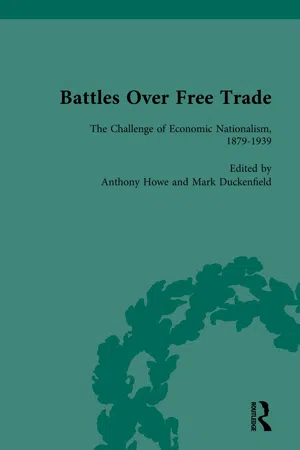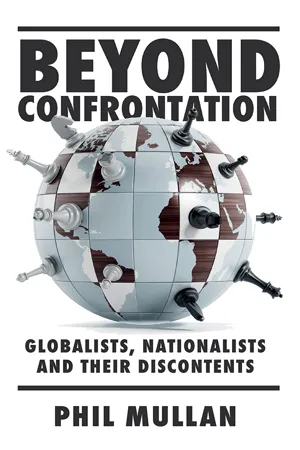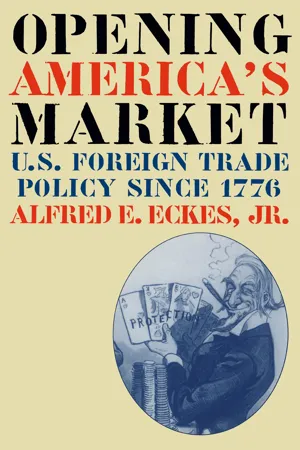History
Smoot Hawley Tariff
The Smoot-Hawley Tariff, enacted in 1930, was a U.S. legislation that significantly raised tariffs on imported goods. Intended to protect American industries during the Great Depression, it led to retaliatory tariffs from other countries, exacerbating global economic downturn. The tariff is often cited as an example of the negative impact of protectionist trade policies on international trade and economic stability.
Written by Perlego with AI-assistance
Related key terms
7 Key excerpts on "Smoot Hawley Tariff"
- eBook - ePub
Peddling Protectionism
Smoot-Hawley and the Great Depression
- Douglas Irwin(Author)
- 2017(Publication Date)
- Princeton University Press(Publisher)
Congressional Record , September 10, 1996, 22513).More than eighty years after the tariff was imposed, Smoot and Hawley are still mentioned in Congress and in newspaper editorials when the debate turns to trade.8 But as time passes, the story sometimes gets distorted. In 2009, Rep. Michele Bachmann (R-MN) made one of the more amusing invocations of Smoot-Hawley when she stated that “the Hoot-Smalley act, which was a tremendous burden on tariff restrictions, and then of course trade barriers and the regulatory burden and tax barriers. That’s what we saw happen under FDR that took a recession and blew it into a full scale depression.”9 Of course, Smoot-Hawley occurred under President Hoover, not President Roosevelt.This 2008 newspaper ad by the Consumer Electronics Association reminded readers of the Smoot-Hawley tariff in seeking support for free trade agreements with Panama, Colombia, and South Korea. Source: CEA. www.ce.orgCOULD SMOOT -HAWLEY RETURN AGAIN?
The reminders of the dark days of the early 1930s have been a check on Congress reasserting itself into the realm of trade policy. Smoot and Hawley have been the bogey men of protectionist trade policy and serve as a warning of what can happen when protectionism gets out of control. As Harvard economist Richard Cooper (1987, 292) has argued:Valuable lessons were learned from the Smoot-Hawley tariff experience by the foreign policy community: the threat of tariff retaliation is not always merely a bluff; tariffs do influence trade flows negatively; a decline in trade can depress national economies; economic depression provides fertile ground for politically radical nostrums; and political radicals often seek foreign (military) adventures to distract domestic attention away from their domestic economic failures. The seeds of World War II, in both the Far East and in Europe, were sowed by Hoover’s signing of the Smoot-Hawley tariff. - eBook - ePub
Battles Over Free Trade, Volume 3
Anglo-American Experiences with International Trade, 1776-2009
- Mark Duckenfield(Author)
- 2017(Publication Date)
- Routledge(Publisher)
The History of Financial Disasters, 1763–1995 , 3 vols (London: Pickering & Chatto, 2006), vol. 3, pp. 26–7.9 C. Kindleberger, The World in Depression.10 R. Smoot, ‘Our Tariff and the Depression’, Current History , 35:2 (1931), p. 174.11 See Herbert Hoover, Statement Upon Signing the Tariff Bill 1930 into Law’, below, pp. 290–312 A. G. Brown, Reluctant Partners: A History of Multilateral Trade Cooperation, 1850– 2000 (Ann Arbor, MI: University of Michigan Press, 2003), pp. 77–9.Passage contains an image
The Smoot-Hawley Tariff, 1930
Republican Party Platform of 1928, 12 June 1928, selection on tariff, Herbert Hoover Presidential Library. TariffWe reaffirm our belief in the protective tariff as a fundamental and essential principle of the economic life of this nation. While certain provisions of the present law require revision in the light of changes in the world competitive situation since its enactment, the record of the United States since 1922 clearly shows that the fundamental protective principle of the law has been fully justified. It has stimulated the development of our natural resources, provided fuller employment at higher wages through the promotion of industrial activity, assured thereby the continuance of the farmer’s major market, and further raised the standards of living and general comfort and well-being of our people. The great expansion in the wealth of our nation during the past fifty years, and particularly in the past decade, could not have been accomplished without a protective tariff system designed to promote the vital interests of all classes.Nor have these manifest benefits been restricted to any particular section of the country. They are enjoyed throughout the land either directly or indirectly. Their stimulus has been felt in industries, farming sections, trade circles, and communities in every quarter. However, we realize that there are certain industries which cannot now successfully compete with foreign producers because of lower foreign wages and a lower cost of living abroad, and we pledge the next Republican Congress to an examination and where necessary a revision of these schedules to the end that American labor in these industries may again command the home market, may maintain its standard of living, and may count upon steady employment in its accustomed field. - eBook - ePub
Beyond Confrontation
Globalists, Nationalists and Their Discontents
- Phil Mullan(Author)
- 2020(Publication Date)
- Emerald Publishing Limited(Publisher)
expansionary . In any case, relative to the production-based drivers of the depression, the direct effects of the tariff were small (Eichengreen, 1986).Irwin also summarised that today most economists “both liberal and conservative, doubt that Smoot–Hawley played much of a role in the subsequent contraction” (Irwin, 2011). Nevertheless other, mostly non-specialist, pundits continue to link a 1930s protectionist tariff war directly to the Great Depression and to the subsequent global bloodshed.It is also misleading to think we are now so much more enlightened about, and critical of, tariffs’ deleterious economic effects than people were in the 1930s. In fact, the economic arguments against the use of tariffs had been well known by policy-makers since the early nineteenth century . For developed countries, tariffs were recognised to be a blunt and self-harming instrument. They damaged some domestic producers as well as pushing up some prices for consumers. Meanwhile, retaliation by other countries could hit exports. Business organisations already had a critical view of these beggar-thy-neighbour policies well before the 1930s slump. The International Chamber of Commerce, for instance, had previously made clear most Western businesses’ opposition to tariffs and their wish for a “world without walls” (Slobodian, 2018, pp. 36–37).The Rise and Fall of 1930s TariffsThroughout the twentieth century, tariffs were not usually introduced as an actual weapon to punish or damage others. Instead, governments imposed them in the hope of offsetting economic difficulties at home, by keeping out imports. Additionally, until the mid-1930s, they were one of the few anti-crisis tools governments adopted. Still under the influence of traditional economic orthodoxies, other ways of coping with economic slowdowns were thought to be worse than tariffs. - eBook - ePub
Opening America's Market
U.S. Foreign Trade Policy Since 1776
- Alfred E. Eckes(Author)
- 2000(Publication Date)
- The University of North Carolina Press(Publisher)
42Interestingly, Eichengreen questions the extent of actual retaliation, suggesting that contemporary writers proceeded “on the assumption that foreign tariffs were retaliatory, interpreting and selecting evidence accordingly.” He asserts that “in light of the biases of earlier literature” it is appropriate to “take a skeptical view of its generality.”43Reassessing Protests and Retaliation
Because it is not possible to demonstrate a causal relationship between higher tariff rates and reduced U.S. imports, those who believe Smoot-Hawley harmed world trade and other economies must demonstrate that foreign protests and retaliation actually depressed U.S. exports. Joseph Jones Jr., a twenty-six-year-old graduate student at the University of Pennsylvania, set out to prove this relationship in his 1934 book, Tariff Retaliation . In introducing the study, Jones boldly asserted thatnever has the United States in peace time experienced such an extended and violent foreign reaction to any piece of local legislation as that attending the Tariff Act of 1930. . . . The often-quoted formal and official protests of thirty-three foreign nations to the United States Government sink into insignificance beside the general protest and indignation of the populations of the principal trading nations of the world as expressed through an outraged press, mass meetings, and resolutions of trade, industrial, and labor organizations in the various countries.44 - eBook - ePub
Panic, Prosperity, and Progress
Five Centuries of History and the Markets
- Timothy Knight(Author)
- 2014(Publication Date)
- Wiley(Publisher)
Earlier, in the spring of 1929, when the stock market was still in its ascendency, there had been some growing concerns about subtle signs of slowdown in American business, certainly in the long-suffering farmland, and also in the important automobile sector. In April 1929, Congressman Willis Hawley introduced a bill that newly inaugurated President Herbert Hoover hoped would help the American farmer.The bill, which was largely aimed at farmers when it was first conjured, was swiftly passed by the House, but over the course of the next year, it would grow into an unwieldy, all-encompassing law that would touch on 20,000 different goods. What would eventually be known as the Smoot-Hawley Tariff was formally known by the much longer and more cumbersome title:An Act To provide revenue, to regulate commerce with foreign countries, to encourage the industries of the United States, to protect American labor, and for other purposes.By the time the act was finalized and offered to the President, economists pleaded with Hoover not to sign it. A thousand economists signed a petition pleading with Hoover to veto the bill, with one of them, a J. P. Morgan partner named Thomas Lamont, recalled that “I almost went down on my knees to beg Herbert Hoover to veto the asinine Hawley-Smoot Tariff. That act intensified nationalism all over the world.”Historians now widely agree that the new tariffs were ruinous for the world economy of the early 1930s. Predictably, nations that traded with the United States erected their own retaliatory tariffs, and the already-suffering global economy was almost completely choked off. In what would become a theme for his efforts, Hoover’s good intentions to turn the economy around ultimately turned disastrous.■ Business Council
As an experienced and successful businessman himself, Hoover believed that the people best equipped to guide the nation out of the financial shock of the market crash were the business leaders of the nation, so he summoned them to the White House soon after the events of October. Hoover’s Treasury secretary, famed banker Andrew Mellon, urged the president to simply leave things alone and let nature take its course. - Katherine A.S. Sibley(Author)
- 2014(Publication Date)
- Wiley-Blackwell(Publisher)
On June 17, 1930, Herbert Hoover signed the Smoot–Hawley Tariff Act (SHT) into law. The SHT has come to be regarded as the worst example of protectionist folly in US political history, and is often blamed for the Great Depression (Irwin 2011: 203–213). Two hundred pages long, the SHT was produced in a convoluted eighteen-month-long legislative process, with only minimal input from Hoover. The original 1928 proposal, which Hoover supported, called for increasing tariffs on agricultural goods only, but Congress bowed to special interests and, despite Hoover’s objections, raised tariffs on manufactured goods as well. Out of 3,293 dutiable items, the SHT raised tariffs on 887 items and lowered tariffs on 235. Hoover signed the SHT Bill despite his own reservations and the public opposition of 1,028 economists (Barber 1985: 85, 99; Irwin 2011: 71, 83–92).The consensus of economic historians is that the SHT “exacerbated the Great Depression” (Whaples 1995) but was not its leading cause. The most comprehensive work on the SHT is Douglas Irwin’s Peddling Protectionism: Smoot–Hawley and the Great Depression (2011). Irwin condemns the SHT on both political and economic grounds, but at the same time convincingly debunks the myth that the SHT caused the Depression.Irwin calculates that the SHT increased the average tariff rate on dutiable goods by 18 percent. For a dutiable good with a pre-tariff price of $1, the tariff-inclusive price was $1.38 before the SHT and $1.45 afterwards. Thus, the SHT-induced increase in the tariff-inclusive price was just 5 percent. In 1929, dutiable imports accounted for one-third of US imports and just 1.4 percent of Gross Domestic Product (GDP). A 5 percent price increase applied to 1.4 percent of GDP could not have done major damage. But we must consider two additional factors: the effect of deflation on tariff rates, and the effect of foreign retaliation on US exports.In 1929, two-thirds of tariffs were “specific”; that is, importers were assessed a fixed dollar amount per unit. Pre-tariff import prices fell by 50 percent over 1930–32, but on those “specific” items, the tariff remained unchanged and became an ever larger percentage of the item’s cost. Irwin gives the following example. Consider a specific tariff of $5 per imported shirt. If the pre-tariff price is $20 per shirt, the $5 specific tariff amounts to 25 percent of the pre-tariff price. Now suppose that the pre-tariff price falls to $10. Now, the $5 specific tariff amounts to 50 percent of the pre-tariff price. He calculates that approximately one-third of the rise in the average tariff percentage was due to SHT, and two-thirds was due to deflation (Irwin 2011: 101–114).- eBook - ePub
- W. Charles Sawyer, Richard L. Sprinkle(Authors)
- 2020(Publication Date)
- Routledge(Publisher)
- In response to the onset of the Great Depression, the U.S. passed the Smoot–Hawley Tariff. This raised tariffs to the highest level in U.S. history.
- The U.S. government passed the Reciprocal Trade Agreements Act in 1934, which is the basis of all subsequent U.S. trade policy. The Act mandated reciprocity in trade negotiations; transferred much of Congressional authority in trade policy to the president; and required the use of MFN.
- There are three forms of administered protection: antidumping, countervailing duties, and the escape clause. Antidumping law prohibits the sale of foreign goods in the U.S. if they are being sold at less than the cost of production or at a price lower than that charged in the foreign market. Countervailing duties are used to offset foreign export subsidies. The escape clause is a means by which U.S. imports suffering from import competition can obtain temporary protection in order to restructure and become more competitive.
- In 1944, the allied countries met at Bretton Woods, New Hampshire, to set guidelines for the operation of the world economy after the war. The International Trade Organization (ITO) was developed to complement the activities of the IMF and World Bank but was never ratified by the U.S. Congress and did not go into effect. Through an administrative agreement, an interim committee called General Agreement on Tariffs and Trade (GATT) had been created to launch the ITO. GATT remained in existence for nearly fifty years.
- Upon entering GATT, countries must adopt most-favored-nation tariffs with respect to all other contracting parties. GATT’s first order of business was to reduce the high tariffs left over from the 1930s and over the next fifty years, tariffs were reduced in a number of multilateral trade negotiations.
Learn about this page
Index pages curate the most relevant extracts from our library of academic textbooks. They’ve been created using an in-house natural language model (NLM), each adding context and meaning to key research topics.






